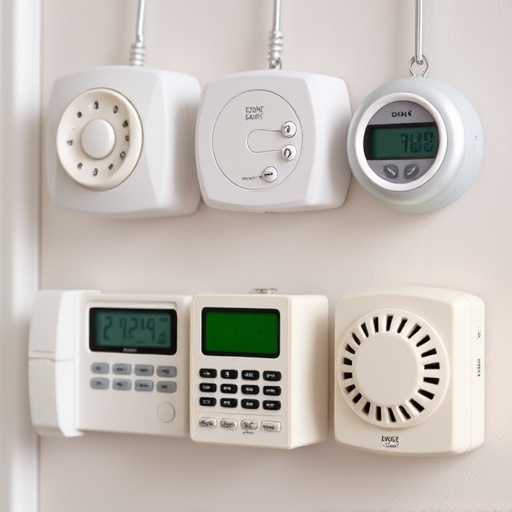Emergency SOS alarms integrated with smartphone connectivity offer enhanced personal safety by providing swift assistance through pre-programmed contacts, location data, and real-time tracking. These devices deter attackers with loud sirens and minimize false alarms by learning individual patterns, ensuring faster response times during genuine emergencies. Best practices include proper education, sensitivity settings adjustments, regular maintenance, and responsible usage to avoid embarrassing false alerts and maintain the effectiveness of emergency responses.
“In today’s digital age, personal safety has never been more crucial. Emergency SOS alarms with smartphone connectivity offer a revolutionary way to enhance your security. This article explores the power of these life-saving tools, delving into their core functionality and how they integrate with smartphones. We weigh the pros and cons of false alarm systems, providing insights on effective use. Discover best practices to ensure these devices serve their purpose without unnecessary triggers, ultimately empowering individuals to prioritize personal safety.”
- Understanding Emergency SOS Alarms: A Lifesaving Tool
- Smartphone Integration: Enhancing Personal Safety
- The Pros and Cons of False Alarm Systems
- Best Practices for Effective Use: Avoiding Unnecessary Triggers
Understanding Emergency SOS Alarms: A Lifesaving Tool
Emergency SOS alarms, with their integration of smartphone connectivity, have evolved into a powerful tool for personal safety. These devices allow individuals to quickly and discreetly summon help in dire situations, such as accidents or emergencies. The alarm triggers a series of actions, including sending pre-programmed emergency contacts a notification along with the user’s location, activating a loud siren to deter potential attackers, and even providing real-time tracking for rescue teams.
Unlike false alarms that can cause inconvenience, these SOS alarms are designed to save lives by ensuring immediate assistance. Their reliability is crucial in high-stress scenarios where split-second decisions matter. With just one press of a button or an automatic activation through predefined triggers, users can connect with help swiftly, making them an invaluable asset for personal safety in today’s digital age.
Smartphone Integration: Enhancing Personal Safety
Smartphone integration in emergency SOS alarms marks a significant advancement in personal safety. With just a simple tap on your screen, users can activate an alarm that connects them to emergency services via their mobile device. This technology ensures that help can be dispatched swiftly and accurately, especially when individuals are unable to speak or move due to distress or injury.
By integrating smartphones with SOS alarms, the risk of false alarms is minimized. The user can verify and control the activation through their phone, preventing unnecessary emergency responses. Moreover, smartphone connectivity allows for real-time updates on the user’s location, enabling efficient navigation for rescue teams, and reducing response times in case of a genuine emergency.
The Pros and Cons of False Alarm Systems
False alarm systems, while a common concern with emergency SOS alarms connected to smartphones, have both advantages and disadvantages. One benefit is the potential to avoid unnecessary panic and distress calls, ensuring resources are preserved for genuine emergencies. A Personal Safety Siren designed to reduce false alarms can learn patterns, differentiate between normal activities and true crises, and significantly cut down on wasted responses from emergency services.
However, the cons of these systems should not be overlooked. Frequent false alarms can desensitize responders, potentially leading to delays in real emergency situations. Moreover, incorrect activation might cause embarrassment or anxiety for the user, eroding trust in the technology. Proper education and sensitive settings adjustments are crucial to mitigate these drawbacks, ensuring that smartphone-connected SOS alarms enhance personal safety without compromising effectiveness.
Best Practices for Effective Use: Avoiding Unnecessary Triggers
When utilizing emergency SOS alarms with smartphone connectivity, it’s crucial to adhere to best practices to ensure effective deployment and avoid unnecessary triggers. Users should familiarize themselves with the alarm system, understanding its functionality and sensitivity levels. Regularly testing the alarm through simulated scenarios can help in gauging its responsiveness while minimizing false alerts. Educating family members or roommates about the alarm’s purpose and proper usage is also vital; this includes clear communication about what constitutes an actual emergency.
Avoiding unnecessary triggers involves being mindful of the alarm’s sensitivity settings, especially in environments with potential sources of false alarms, such as busy households or areas prone to environmental noise. Adjusting sensitivity levels can help prevent accidental activations caused by everyday sounds. Regular maintenance and prompt reporting of any technical glitches or issues will also contribute to reliable operation when it matters most. Remember, a well-regulated SOS alarm system is a powerful tool for personal safety, but its effectiveness hinges on responsible use and awareness.
Emergency SOS alarms with smartphone connectivity are powerful tools that significantly enhance personal safety. By integrating these devices with our mobile phones, we gain a critical edge in emergency situations, ensuring swift assistance and potentially saving lives. However, it’s crucial to balance the benefits against the risk of false alarm triggers. Through best practices, such as clear communication and proper understanding of activation criteria, we can maximize the effectiveness of these systems while minimizing unnecessary responses, ultimately contributing to safer communities.
